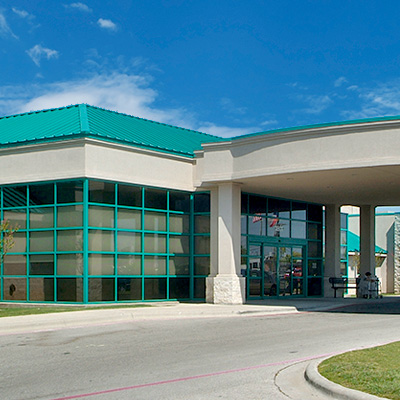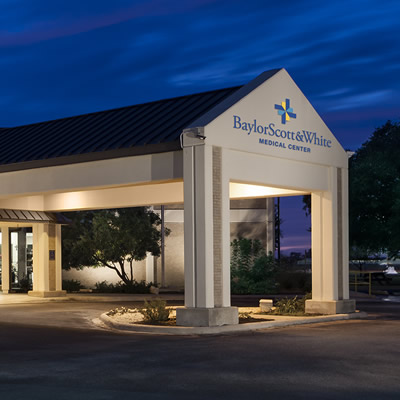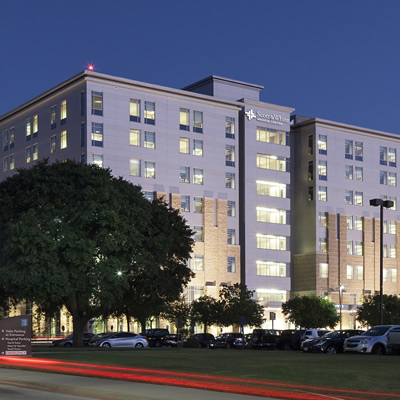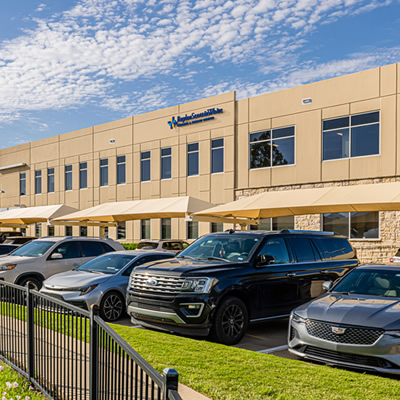Diagnostic mammograms save lives
When you or your doctor notices a change in your breast health, you want immediate care from an experienced team. Our imaging centers offer advanced diagnostic mammography technology, including 3D mammography, to help you get the answers you need, when and where you need them.
A diagnostic mammogram can help detect various breast conditions, from breast cysts to breast cancer. But most of the time, diagnostic mammograms don’t find any additional areas of concern. If you need more care after your test, our complete breast care program gives you access to resources and guidance for your next steps.
What is a diagnostic mammogram?
A diagnostic mammogram uses X-ray images to give your care team more details about your breast health. Only about 10% of diagnostic mammograms need to be followed by a breast biopsy to further investigate areas of concern.
Your healthcare provider may order a diagnostic mammogram as a follow-up to a screening mammogram or breast exam. You may also have a diagnostic mammogram if you have symptoms, such as:
- Breast lump
- Breast pain
- Breast rash or skin changes
- Nipple discharge
- Breast shape or size changes
Screening mammography vs. diagnostic mammography
Screening mammography offers a preventive step to check your health when you don’t have any breast symptoms. Diagnostic mammography is used when a screening mammogram shows something that needs additional imaging or when you have breast symptoms.
Diagnostic mammograms can help provide more information about a new breast symptom or area of concern, capture more detailed images of your breast and help determine if you need follow-up testing. They may require extra time because more images are taken.
How to prepare for a diagnostic mammogram
The process for getting a diagnostic mammogram is similar to having a screening mammogram. To help your test go as smoothly as possible, there are a few things you can do to prepare.
Before your mammogram
- Make sure the center has copies of any previous mammography images.
- Let the center know if you have breast implants, are breastfeeding or recently had a vaccine.
- Contact us with any questions.
On the day of your mammogram
- Follow your normal routine for eating and taking medications.
- Avoid using lotions, powders or deodorant in your underarms or breast area.
- Wear a comfortable two-piece outfit to undress from the waist up.
- Bring your ID and insurance card to your appointment.
Finding diagnostic mammography locations
We help you get care at a location that fits your needs. We offer several locations for your care, including mammogram centers in North and Central Texas.

Baylor Scott & White - The Brenham Clinic
600 N Park St , Brenham, TX, 77833- Monday: 7:30 am - 5:00 pm
- Tuesday: 7:30 am - 5:00 pm
- Wednesday: 7:30 am - 5:00 pm
- Thursday: 7:30 am - 5:00 pm
- Friday: 7:30 am - 5:00 pm

Baylor Scott & White Clinic - Brenham Hwy 290
604 US 290 , Brenham, TX, 77833- Monday: 7:00 am - 7:00 pm
- Tuesday: 7:00 am - 5:00 pm
- Wednesday: 7:00 am - 5:00 pm
- Thursday: 7:00 am - 7:00 pm
- Friday: 7:00 am - 5:00 pm
- Saturday: 8:00 am - 12:00 pm

Baylor Scott & White Clinic - Cedar Park
910 E Whitestone Blvd , Cedar Park, TX, 78613- Monday: 8:00 am - 5:00 pm
- Tuesday: 8:00 am - 5:00 pm
- Wednesday: 8:00 am - 5:00 pm
- Thursday: 8:00 am - 5:00 pm
- Friday: 8:00 am - 5:00 pm
- Monday: 7:00 am - 4:30 pm
- Tuesday: 7:00 am - 4:30 pm
- Wednesday: 7:00 am - 4:30 pm
- Thursday: 7:00 am - 4:30 pm
- Friday: 7:00 am - 4:30 pm
- Saturday: 9:00 am - 4:30 pm
- Sunday: 9:00 am - 4:30 pm

Baylor Scott & White Clinic - College Station Rock Prairie
800 Scott and White Dr , College Station, TX, 77845- Monday: 7:30 am - 5:00 pm
- Tuesday: 7:30 am - 5:00 pm
- Wednesday: 7:30 am - 5:00 pm
- Thursday: 7:30 am - 5:00 pm
- Friday: 7:30 am - 5:00 pm

Baylor Scott & White Clinic - Georgetown
4945 Williams Dr , Georgetown, TX, 78633- Monday: 7:30 am - 5:00 pm
- Tuesday: 7:30 am - 5:00 pm
- Wednesday: 7:30 am - 5:00 pm
- Thursday: 7:30 am - 5:00 pm
- Friday: 7:30 am - 5:00 pm

Baylor Scott & White Clinic - Killeen
3801 Scott and White Dr , Killeen, TX, 76543- Monday: 7:00 am - 7:00 pm
- Tuesday: 7:00 am - 7:00 pm
- Wednesday: 7:00 am - 7:00 pm
- Thursday: 7:00 am - 7:00 pm
- Friday: 7:00 am - 7:00 pm
- Saturday: 7:00 am - 7:00 pm

Baylor Scott & White Clinic - Temple
2401 S 31st St , Temple, TX, 76508- Monday: 8:00 am - 5:00 pm
- Tuesday: 8:00 am - 5:00 pm
- Wednesday: 8:00 am - 5:00 pm
- Thursday: 8:00 am - 5:00 pm
- Friday: 8:00 am - 5:00 pm

Baylor Scott & White Clinic - Waco
7700 Fish Pond Rd , Waco, TX, 76710- Monday: 8:00 am - 5:00 pm
- Tuesday: 8:00 am - 5:00 pm
- Wednesday: 8:00 am - 5:00 pm
- Thursday: 8:00 am - 5:00 pm
- Friday: 8:00 am - 5:00 pm

Baylor Scott & White Darlene G. Cass Women's Imaging Center at Junius
3900 Junius St Ste 200, Dallas, TX, 75246
Baylor Scott & White Darlene G. Cass Women's Imaging Center at North Dallas
9101 N Central Expy Ste 200, Dallas, TX, 75231
Baylor Scott & White Elizabeth Jekot, MD Women's Imaging Center - Richardson
3301 E Renner Rd Ste 100, Richardson, TX, 75082
Baylor Scott & White Hillcrest Breast Center - Waco
50 Hillcrest Medical Blvd Bldg I, Ste 103-B, Waco, TX, 76712- Monday: 7:00 am - 6:30 pm
- Tuesday: 7:00 am - 6:30 pm
- Wednesday: 7:00 am - 6:30 pm
- Thursday: 7:00 am - 5:00 pm
- Friday: 7:00 am - 3:00 pm

Baylor Scott & White Imaging Center - Forney
763 E US Hwy 80 Ste 120, Forney, TX, 75126- Monday: 8:00 am - 5:00 pm
- Tuesday: 8:00 am - 5:00 pm
- Wednesday: 8:00 am - 5:00 pm
- Thursday: 8:00 am - 5:00 pm
- Friday: 8:00 am - 5:00 pm

Baylor Scott & White Imaging Center - Greenville
4400 Interstate 30 W Ste 200, Greenville, TX, 75402- Monday: 8:00 am - 5:00 pm
- Tuesday: 8:00 am - 5:00 pm
- Wednesday: 8:00 am - 5:00 pm
- Thursday: 8:00 am - 5:00 pm
- Friday: 8:00 am - 5:00 pm

Baylor Scott & White Medical Center - Austin
5245 W US Hwy 290 Service Rd , Austin, TX, 78735
Baylor Scott & White Medical Center - College Station
700 Scott and White Dr , College Station, TX, 77845
Baylor Scott & White Medical Center - Lakeway
100 Medical Pkwy , Lakeway, TX, 78738
Baylor Scott & White Medical Center - Marble Falls
810 W State Hwy 71 , Marble Falls, TX, 78654
Baylor Scott & White Medical Center - Pflugerville
2600 E Pflugerville Pkwy Ste 100, Pflugerville, TX, 78660
Baylor Scott & White Medical Center - Plano
4700 Alliance Blvd , Plano, TX, 75093
Baylor Scott & White Medical Center - Round Rock
300 University Blvd , Round Rock, TX, 78665
Baylor Scott & White Medical Center - Taylor
305 Mallard Ln , Taylor, TX, 76574
Baylor Scott & White Medical Center - Temple
2401 S 31st St , Temple, TX, 76508
Baylor Scott & White Medical Center - Waxahachie
2400 N Interstate 35E , Waxahachie, TX, 75165
Baylor Scott & White Obstetrics & Gynecology - Rockwall
1005 W Ralph Hall Pkwy Ste 115, Rockwall, TX, 75032- Monday: 8:00 am - 5:00 pm
- Tuesday: 8:00 am - 5:00 pm
- Wednesday: 8:00 am - 5:00 pm
- Thursday: 8:00 am - 5:00 pm
- Friday: 8:00 am - 5:00 pm

Baylor Scott & White Vasicek Cancer Treatment Center - Temple
2401 S 31st St , Temple, TX, 76508- Monday: 8:00 am - 5:00 pm
- Tuesday: 8:00 am - 5:00 pm
- Wednesday: 8:00 am - 5:00 pm
- Thursday: 8:00 am - 5:00 pm
- Friday: 8:00 am - 5:00 pm

Baylor Scott & White Women's Imaging Center - Irving (MacArthur & Hwy 183)
2001 N MacArthur Blvd Ste 250, Irving, TX, 75061
Baylor Scott & White Women's Imaging Center - Las Colinas (MacArthur & I-635)
440 W Lyndon B Johnson Fwy Plaza II, Ste 120A, Irving, TX, 75063
Baylor Scott & White Women's Imaging Center - McKinney
5236 W University Dr Ste 2500, McKinney, TX, 75071- Monday: 8:00 am - 4:30 pm
- Tuesday: 8:00 am - 4:30 pm
- Wednesday: 8:00 am - 4:30 pm
- Thursday: 8:00 am - 4:30 pm
- Friday: 8:00 am - 4:30 pm

Baylor Scott & White Women's Imaging Center - Plano
4716 Alliance Blvd Pavilion II, Ste 100, Plano, TX, 75093
Baylor University Medical Center, part of Baylor Scott & White Health
3500 Gaston Ave , Dallas, TX, 75246
Breast Center at Baylor Scott & White - Grapevine
1631 Lancaster Dr Ste 130, Grapevine, TX, 76051
Touchstone Imaging Arlington
601 W Arbrook Blvd , Arlington, TX, 76014
Touchstone Imaging Burleson
665 NE Alsbury Blvd , Burleson, TX, 76028
Touchstone Imaging Downtown Fort Worth Rosedale
1701 W Rosedale St , Fort Worth, TX, 76104- Monday: 7:00 am - 7:00 pm
- Tuesday: 7:00 am - 7:00 pm
- Wednesday: 7:00 am - 7:00 pm
- Thursday: 7:00 am - 7:00 pm
- Friday: 7:00 am - 7:00 pm
- Saturday: 8:00 am - 12:00 pm

Touchstone Imaging Forest Lane
11617 N Central Expy Ste 132, Dallas, TX, 75243
Touchstone Imaging Fossil Creek
5455 Basswood Blvd Ste 550, Fort Worth, TX, 76137
Touchstone Imaging Grand Prairie
2740 N State Hwy 360 Ste 200, Grand Prairie, TX, 75050
Touchstone Imaging Hurst
1717 Precinct Line Rd Ste 103, Hurst, TX, 76054
Touchstone Imaging Keller
601 S Main St Ste 100, Keller, TX, 76248
Touchstone Imaging Lewisville
190 Civic Cir Ste 125, Lewisville, TX, 75067
Touchstone Imaging McKinney
5321 W University Dr , McKinney, TX, 75071
Touchstone Imaging Mesquite
1425 Gross Rd Ste 130, Mesquite, TX, 75149
Touchstone Imaging Midlothian-Midway
4431 E US Hwy 287 Ste 120 , Midlothian, TX, 76065Hours of Operation
Hours of Operation
Office Hours
Frequently asked questions
-
Why do I need a diagnostic mammogram and ultrasound?
Diagnostic mammograms and ultrasounds help your care team get more images and information about your breast symptoms or a specific area in your breast. Some normal breast features, like having dense breast tissue, may make it more likely that you’ll need a diagnostic mammogram, ultrasound or other breast imaging.
-
Are diagnostic mammograms covered by insurance?
Your insurance may cover part of the cost of your diagnostic mammogram. However, your standard copays or deductibles may apply because it is not a screening mammogram. Check with your insurance provider for questions about your coverage.
-
What is the difference between a regular mammogram and a diagnostic mammogram?
Both annual screening and diagnostic mammograms take X-ray images of the breast tissue. But during a diagnostic mammogram, you’ll have more images taken, such as from different angles or to focus on specific areas of the breast.
These images give the radiologist a more detailed view of your breast tissue and help determine if your symptoms or areas of concern need additional testing.
-
How long does a diagnostic mammogram take?
A diagnostic mammogram can take up to an hour because it may include more images of the breast than a screening mammogram. The radiologist will provide results faster than a screening mammogram, often at the end of your appointment.
-
Why would a diagnostic mammogram be ordered?
There are three main reasons why your doctor might order a diagnostic mammogram:
- As a follow-up to a screening mammogram to get additional images
- After a clinical breast exam that finds a lump or other breast symptoms
- To check on a new breast symptom that you notice during a self-exam
Remember, a diagnostic mammogram is not a diagnosis of a condition. It simply gives your healthcare providers more information to guide your care.